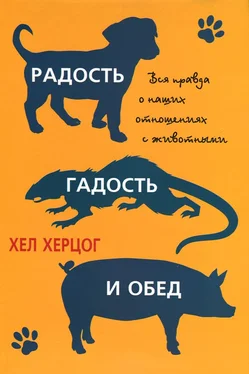203. …петушиные бои стали незаконными во всех штатах. — Однако петушиные бои остаются вполне законным занятием на таких американских территориях, как Пуэрто-Рико, Гуам, Самоа и Виргинские острова.
203. Существовавшее в восемнадцатом веке движение против кровавого спорта… — См. Thomas, К. (1983). Man and the natural world: A history of the modern sensibility. New York: Pantheon.
203. …эссе, опубликованном в Atlanta Journal Constitution… — Rudy, K. (September 6, 2007). Dog-fighting and Michael Vick. Atlanta journal Constitution.
204. То же самое происходит и на скачках, где состязаются чистокровные скакуны. — McMurray, J. (June 14, 2008). АР finds 5К horse deaths since 03. Washinglonpost.com.
208. Вы спрашиваете, почему я не ем мяса. — Coetzee, J. М. (2003). Elizabeth Costello. New York: Penguin Books.
208. …выросло в шесть раз в Японии и в пятнадцать раз в Китае. — Halweil, В., & Nierenberg, D. (2008). Meat and seafood: The global diets most costly ingredients. In Worldwatch Institute (ed.), 2008 State of the World: Innovation for a sustainable economy (p. 61–74). Washington, DC: Worldwatch Institute.
209. …беспокоиться не столько за твой уровень холестерина, сколько за твое душевное здоровье. — Bruni, Е (2009, May 20). Beef and decor, aged to perfection. New York Times.
210. Наши ближайшие родственники, шимпанзе, тоже любят вкус мяса. — Дополнительную информацию о роли мяса в рационе шимпанзе см. у Stanford, С. В. (1999). The hunting ape: Meat eating and the origins of human behavior. Princeton, NJ: Princeton University Press; Stanford, C. (2002). significant others: The ape-human continuum and the quest for human nature. New York: Basic Books. Boesch, C. (1994). Hunting strategies of Gombe and Tai chimpanzees. In R. W. Wrangham, W. C. McGrew, F. B. M de Waal & P. G. Heltne (eds.), Chimpanzee cultures (p. 76–92). Cambridge, MA: Harvard University Press.; Foley, R. (2001). The evolutionary consequences of increased carnivory. In С. B. Stanford & H-.T, Bunn (eds)., Meat-eating and human evolution (pp. 305–331). New York: Oxford University Press. The exchange of meat for sex is described in Gomes, С. M. & Boesch. C. (2009). Wild chimpanzees exchange meat for sex on a longterm basis. PLoS ONE, 4, e5i 16 211. …писал, что паши предки были кровожадными убийцами… — Stanford, С. В. (1999). The hunting ape: Meat eating and the origins of human behavior. Princeton, NJ: Princeton University Press, (p. 107).
211. …калорий, потребляемых народностями Северной Аляски… — Cordain, L., Eaton, S., Brand Miller, J., Mann, N., 8c Hill, K. (2002). The paradoxical nature of hunter-gatherer diets: Meat-based, yet non-atherogenic. European Journal of Clinical Nutrition, 56(1), 42–52.; Gadsby, P. (October 1, 2004). The Inuit paradox. Discover Magazine.
212. He было ни одного сообщества охотников-собирателей… — Cordain, L., Eaton, S. B., Sebastian, A., Mann, N.. Lindeberg, S., Watkins, B. A., et al. (2005). origins and evolution of the Western diet: Health implications for the 21st century. American Journal of Clinical Nutrition, 81 (2), 341–354.
214. …восприимчивы к разного рода бактериям, вирусам, простейшим, амебам и паразитам… — New Brunswick, NJ: Rutgers University Press; Finch, С. E., & Stanford, С. B. (2004). Meat-adaptive genes and the evolution of slower aging in humans. The Quarterly Review of Biology, 79(1), 3–50. Chitnis, A., Rauls, D. and Moore, J. (2000) «origin of HIVType 1 in colonial French Equatorial Africa?» AIDS Research and Human Retroviruses, 16(1) 5–8.
214. …только человек сдабривает пищу специями… — Вкус чили неприятен и человеческим детям. Исследования Пола Розина показали, что человеку нужно еще научиться получать удовольствие от жгучего перца. Rozin, Р., & Schiller, D. (1980). The nature and acquisition of a preference for chili pepper by humans. Motivation and Emotion, 4(1), 77–101.
215. …мясоедение остается рискованным занятием… — Fessler, D. М. Г. (2002). Reproductive immunosuppression and diet, Current Anthropology, 43(1), 19–61.; Flaxman, S. М., & Sherman, P. W. (2000). Morning sickness: A mechanism for protecting mother and embryo. Quarterly Review of Biology. 75(2), 113–148.
217. …отвращение к мясу встречается втрое чаще, чем отвращение к овощам, и вшестеро чаще, чем отвращение к фруктам. — MidkifF, Е. Е., & Bernstein, I. L. (1985). Targets of learned food aversions in humans. Physiology & Behavior, 34(5у 839–841.
217. …пищевые табу, существующие в различных сообществах. — Fessler, D., & Navarrete, С. (2003). Meat is good to taboo: Dietary proscriptions as a product of the interaction of psychological mechanisms and social processes. Journal of Cognition and Culture, 3(1), 1–40.
218. …запретом на буйволиное мясо… — Случай описан у McDonaugh, С. (1997). Breaking the rules: Changes in food acceptability among the Tharu of Nepal. In H. Macbeth (ed.), Food preferences and taste: Continuity and change. Oxford, UK: Berghahn Books.
219. Большинству американцев особенно отвратительна мысль о поедании собачатины… — Не все американцы испытывают отвращение перед собачатиной. У живущих в Калифорнии филиппинцев собачье мясо входит в состав традиционных блюд и подается в особых случаях, например на свадьбах. Практика собакоедения послужила причиной конфликта между филиппинцами и белыми американцами. После инцидента в 1989 году, когда группа камбоджийских беженцев убила и ободрала щенка немецкой овчарки, намереваясь его съесть, калифорнийские власти добавили в Уголовный кодекс статью 598b, в которой запрещалось приобретать, продавать, ввозить или передавать кому-либо труп «любого животного, которое традиционно занимает место домашнего любимца или обычно является таковым». См. Griffith, М., Wolch, J., Lassiter, U. (2002). Animal practices and the racialization of Filipinas in Los Angeles. Society & Animals, 20(3), 221–248.
219. …люди тысячелетиями ели собак. — Обсуждение исторических и культурных вариаций отношения к собакоедению см. у McHugh, S (2004). Dog. London, GK: Reaktion Books.; Serpell, J. (1995). The hair of the dog. In J. Serpell (ed.), The domestic dog: Its evolution, behavior and interactions with people (p. 257–262). Cambridge, UK: Cambridge University Press; Simoons, F. J. (1994).
Читать дальше




![Катарина Херцог - Фэй. Сердце из лавы и света [litres]](/books/386902/katarina-hercog-fej-serdce-iz-lavy-i-sveta-litre-thumb.webp)



